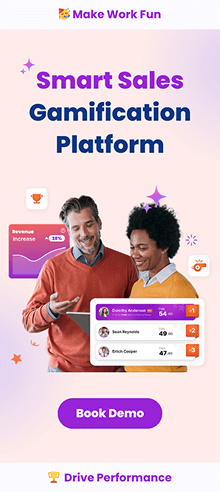In today’s competitive work environment, motivating teams to perform at their peak is both an art and a science. Historically, companies leaned heavily on traditional incentives—bonuses, gift cards, and commission tiers—to push productivity. While those methods aren’t obsolete, they’re increasingly being overshadowed by a new, more dynamic motivator: gamification.
One prime example of gamification in action is the enhancement of loyalty programs. By integrating game design elements, businesses can create dynamic loyalty programs that motivate customers to participate and foster a deeper connection with the brand, ultimately leading to increased customer satisfaction and long-term loyalty.
Gamification brings elements of games—like points, levels, leaderboards, and achievements—into the workplace to drive engagement, enhance performance, and inject fun into daily tasks. But how does it stack up against traditional rewards? More importantly, which method delivers better results?
Understanding Traditional Incentives
Traditional incentives are deeply ingrained in corporate cultures. They focus on external motivators like financial bonuses, prizes, promotions, or a well-structured sales incentive program to encourage desired behavior. The core idea is simple: “Do this, get that.”
While straightforward, this model assumes all employees are driven by the same motivators, and it often overlooks intrinsic factors like purpose, recognition, and enjoyment.

Examples of Common Sales Incentive Programs
Some of the most prevalent traditional incentive programs include:
- Bonuses awarded quarterly or annually
- Employee-of-the-month recognitions
- Commission-based pay structures
- Cash-driven contests
- Holiday rewards or gift vouchers
These incentives are typically linked to achieving specific goals, such as meeting sales quotas or decreasing customer attrition.
The Psychology Behind Traditional Rewards
Traditional incentives operate on the principle of extrinsic motivation—the drive to perform a behavior due to an external reward. While effective in the short term, this model often loses power over time. When the reward is removed, so is the motivation.
Moreover, over-reliance on external rewards can reduce creativity and innovation, as employees may focus only on tasks that lead to incentives.
Limitations of Traditional Incentives
- Short-lived motivation: Traditional incentives provide a temporary boost in motivation that only lasts until the reward is received. Once the external motivator is gone, employees may revert to previous behavior, leading to inconsistent performance.
- Inequity and favoritism: Subjective criteria for rewards can foster resentment among employees, creating a perception of favoritism and unfairness. This can harm team dynamics and reduce overall morale.
- Reward dependency: Employees may become reliant on incentives, disengaging when no prize is guaranteed. This dependency can stifle intrinsic motivation, making it difficult to sustain long-term engagement without continuous rewards.
- Not scalable: Traditional incentives can be costly and challenging to maintain, especially as teams grow. The financial burden of these programs can limit their scalability, making them less feasible for larger organizations. While they can drive immediate output, they often struggle to foster sustained engagement or shape lasting behavioral change.
Short-Term vs Long-Term Impact
Traditional rewards work great when you need a short burst of performance, like during a sales blitz. But what happens when the program ends? Momentum fades.
Gamification, on the other hand, is a powerful tool that builds habitual engagement, fosters consistent behaviors, and creates a positive feedback loop that endures—making it ideal for long-term performance gains.
The Rise of Gamification in the Workplace
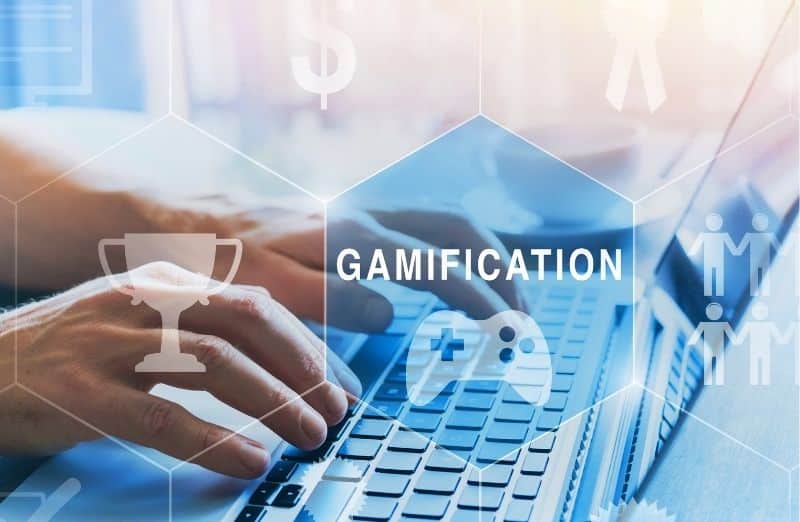
Gamification isn’t new—but its adoption in workplaces is booming. Why? Because today’s workforce is not only digitally savvy but also constantly craving feedback and motivated by autonomy and mastery. By integrating game mechanics into daily tasks, gamification transforms work into an interactive, rewarding experience where recognition, progress, and competition fuel daily wins.
This approach caters to the modern employee’s desire for immediate feedback and personal growth, making it an ideal strategy for enhancing employee motivation and job satisfaction. As gamification strategies continue to evolve, they offer a dynamic way to engage sales teams, encourage desired behaviors, and ultimately lead to more sales and improved performance.
What Is Gamification?
Gamification applies game mechanics like points, levels, badges, leaderboards, and missions to non-game contexts such as sales, support, training, and onboarding. By integrating these elements, organizations aim to boost participation, engagement, and performance, making work more enjoyable and dynamic.
For example, platforms like Duolingo use gamified lessons to enhance the language learning experience. By integrating gamification into the learning process, they create engaging and effective challenges that motivate users to participate and progress.
This approach transforms routine tasks into interactive challenges, encouraging employees to actively participate and stay motivated. With gamification strategies, sales teams can visualize their progress, receive tailored feedback, and experience a sense of accomplishment, ultimately leading to enhanced employee satisfaction and sustained job performance.
Definition and Key Elements of Gamification
Gamification is the process of incorporating game elements and mechanics into non-game contexts, such as sales, marketing, and education, to increase engagement, motivation, and participation. At its core, gamification leverages game mechanics—like points, badges, and leaderboards—to create a dynamic and interactive experience. These elements are designed to make routine tasks more engaging and enjoyable, encouraging individuals to actively participate and stay motivated.
Incorporating game elements into the workplace can transform mundane activities into exciting challenges. For instance, sales teams might earn points for closing deals, level up by hitting targets, and see their names climb leaderboards. This not only boosts motivation but also fosters a sense of accomplishment and progress. By integrating these game mechanics, organizations can create an environment where employees are driven to achieve specific goals and exhibit desired behaviors, ultimately leading to increased engagement and productivity.
How Gamification Works
Let’s say a rep logs five follow-ups in your CRM—they earn points. Hit their call quota for the week? They level up. Top the leaderboard? They get a digital badge and public recognition.
This continuous feedback loop keeps motivation high and performance visible—creating positive pressure to succeed without needing costly external rewards.
Gamification in Sales Teams
Sales is naturally competitive—making it the perfect match for gamification. By incorporating game elements like leaderboards, streaks, and contests, sales reps are motivated to stay consistent and improve their skill sets. This healthy competition encourages sales professionals to push their limits and enhance their performance in a fun and engaging way.
Moreover, gamification provides sales teams with real-time metrics, making it easier to coach and refine sales behavior. This dynamic approach fosters a culture of continuous improvement, where sales reps are driven by both financial rewards and growth opportunities to achieve more sales and close deals, ultimately leading to increased engagement and job satisfaction.
Gamification in Customer Service
In support teams, metrics like response time, resolution rate, and customer satisfaction can be gamified to boost both individual and team performance. By awarding badges for quick responses and granting experience points (XP) for positive reviews, employees are motivated to improve their speed and efficiency. This approach not only enhances productivity but also reduces burnout by making work more engaging and rewarding.

Additionally, gamification fosters a sense of camaraderie and collaboration within teams. As employees strive for common goals, teamwork is encouraged, creating a supportive environment that values both individual achievements and collective success. This dual focus builds pride and performance simultaneously.
Gamification in Employee Onboarding
New hires often encounter a daunting learning curve, but gamified learning transforms this challenge into engaging, manageable tasks. By incorporating game elements, such as earning badges for completing training modules and leveling up by scoring 80% on quizzes, new employees are motivated to actively participate in their learning journey. This interactive learning environment fosters confidence and enhances knowledge retention, allowing new hires to quickly adapt and thrive.
Furthermore, gamified learning encourages continuous improvement by setting milestones that unlock leaderboards, offering immediate feedback and a sense of accomplishment. This approach not only builds critical thinking and problem-solving skills but also integrates new employees into the team effort, promoting a collaborative and dynamic workplace culture.
Gamification vs Cash Bonuses
While cash bonuses provide a momentary thrill, they are often quickly forgotten. Gamification, on the other hand, offers continuous motivation through interactive challenges and immediate feedback. By incorporating game elements, employees are consistently engaged and driven to achieve more, fostering a culture of ongoing improvement. This approach reinforces desired behaviors and enhances employee satisfaction without the recurring expenses associated with traditional incentives.
Additionally, gamification can be used to engage existing customers by leveraging their loyalty and encouraging repeat purchases through interactive and rewarding experiences.
Moreover, gamification provides recognition that is both public and memorable. Employees may not recall a $100 bonus three months later, but they will remember topping the team leaderboard or earning the “Sales Sharpshooter” status, creating lasting motivation and job satisfaction.
Gamification and Continuous Motivation
Unlike traditional rewards, such as cash rewards that are typically distributed on a quarterly or annual basis, gamification offers daily dopamine hits that are essential for maintaining motivation. By providing frequent, small rewards, gamification helps build habits, sustain high morale, and make progress tangible. These micro-wins act as momentum builders, continuously propelling employees forward.
This approach not only encourages employees to stay engaged but also fosters a sense of achievement and satisfaction. As employees experience regular success, they are more likely to remain motivated and committed to their tasks, ultimately leading to improved performance and a more dynamic workplace culture.
Why Recognition Beats Rewards
Recognition serves as a powerful motivator by fostering a sense of community and camaraderie within the workplace. When employees feel acknowledged for their efforts, they are more likely to engage in behaviors that contribute to the overall success of the team. This sense of belonging not only enhances employee motivation but also promotes a positive workplace culture where everyone feels valued and appreciated.
Gamification enhances customer interaction by incorporating random rewards that significantly boost engagement and motivation among participants. These rewards are strategically designed to encourage customers to engage more with the brand, leading to increased feedback and fostering a deeper connection, thereby enhancing overall customer loyalty.
Recognition is public, emotional, and lasting. It:
- Builds belonging
- Encourages repetition of good behaviors
- Doesn’t rely on budgets
Gamification embeds recognition into daily workflows—something cash can’t do.
Furthermore, recognition encourages employees to continue performing well, as they are driven by the desire to receive positive feedback from their peers and superiors. This ongoing encouragement helps maintain high levels of job satisfaction and commitment, ultimately leading to improved performance and productivity.
Unlike traditional incentives that often require substantial financial investment, recognition is a cost-effective way to boost morale and engagement. By integrating recognition into daily workflows through gamification, companies can create a sustainable reward system that continuously motivates employees without the need for frequent monetary rewards. This approach leverages intrinsic motivation, making it a valuable tool for fostering long-term engagement and retention.
Engagement Metrics: Gamification vs Incentives
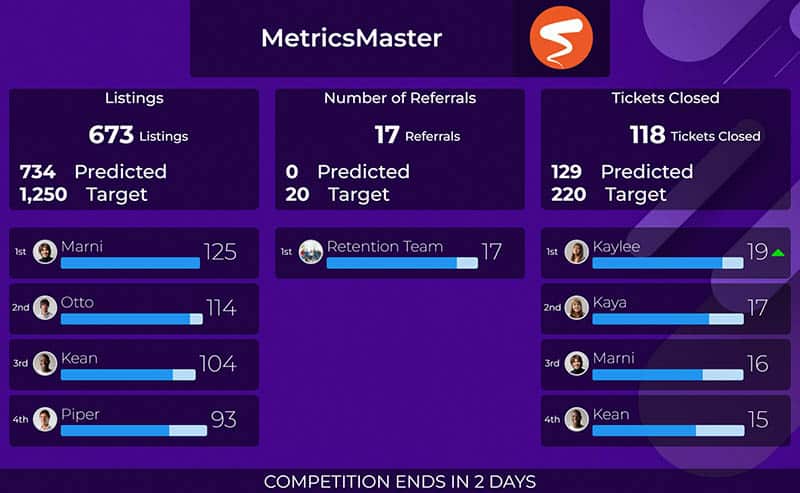
Studies show gamification leads to:
- 48% increase in employee engagement
- 34% higher performance in sales orgs
- 50% lower turnover
These impressive statistics highlight the transformative power of gamification strategies in the modern workplace. By incorporating game mechanics, organizations can create an interactive and engaging environment that not only boosts motivation but also enhances the overall job satisfaction of employees. This approach encourages sales teams and other departments to strive for continuous improvement, ultimately leading to more sales and better performance outcomes.
Traditional incentives struggle to match that—especially in remote or hybrid environments where connection is as critical as compensation. In these settings, gamification serves as a valuable tool for maintaining team cohesion and morale, providing a sense of community and shared purpose. For example, a gamified loyalty program can significantly enhance customer engagement and retention by offering various types of rewards that motivate customers. This fosters loyalty through fun and engaging experiences, creating a more rewarding atmosphere that drives repeat interactions and strengthens brand connections. By integrating gamified elements into daily workflows, companies can effectively bridge the gap between remote team members, ensuring everyone remains engaged and motivated, regardless of their physical location.
Impact on Company Culture
Gamification drives collaboration by encouraging team members to work together towards common goals, fostering a sense of unity and shared success. This approach promotes friendly competition, where employees are motivated to push their limits while supporting their peers, creating a positive and engaging work environment.
Additionally, gamification fosters skill development by providing a safe environment for practicing and refining abilities. This comprehensive approach not only engages learners but also enhances their skills, contributing to both personal and educational growth.
Moreover, gamification enhances visibility within the company, allowing employees to showcase their achievements and contributions. This participatory culture is inclusive, offering everyone the opportunity to excel at their own pace and level. Unlike rigid bonus structures, gamification ensures that recognition and success are accessible to all, ultimately leading to a more cohesive and motivated workforce.
Real-Time Feedback with Gamification
One of the most significant advantages of gamification is its ability to deliver instant feedback. Traditional incentives tend to rely on end-of-quarter assessments or annual reviews, which means employees often wait weeks or even months to understand how they’re performing. By contrast, gamification provides ongoing updates that help employees course-correct in real time.
When reps can see their progress on a leaderboard or receive immediate recognition for a job well done, they naturally gravitate toward consistent, productive behavior. This level of visibility also supports managers, who no longer need to dig through reports to track progress—they can observe, coach, and adjust in the moment. Additionally, real-time feedback can significantly boost engagement by keeping employees motivated and focused on their goals.
Gamification: Empowering Remote and Hybrid Teams for Success
In today’s hybrid work environments, visibility is a challenge. Remote workers can often feel disconnected from the larger mission, and in-office staff may unintentionally receive more recognition simply by being physically present. Gamification helps level that playing field by making contributions visible across locations.
By incorporating gamification, the learning experience for remote teams is significantly enhanced. Effective design elements such as digital leaderboards, achievement badges, and virtual competitions create engaging and motivating environments. This not only promotes active participation but also deepens understanding among team members, ensuring that learning is both enjoyable and effective.
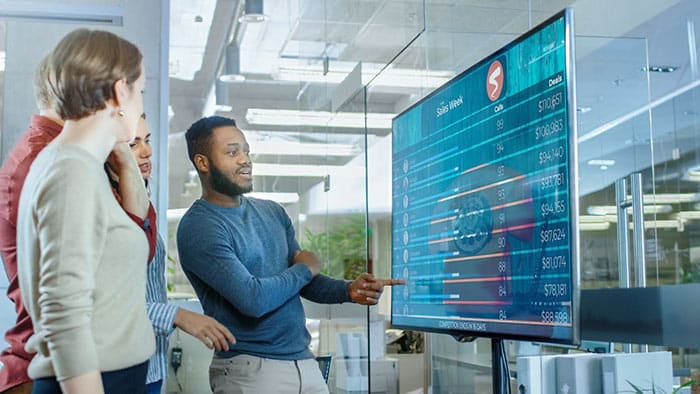
Digital leaderboards, achievement badges, and virtual competitions allow remote employees to feel just as engaged and seen as their in-office counterparts. It fosters inclusion and ensures that everyone, regardless of where they work, has equal access to motivation and recognition.
Traditional Incentives and Proximity Bias
One of the downsides of traditional incentive programs is that they often depend on subjective evaluation—who managers see going “above and beyond.” This introduces proximity bias: the subconscious tendency to favor those who are physically closer or more visible in office settings.
Gamification mitigates this bias by using objective, real-time performance data. Instead of relying on who speaks up in meetings or who stays late in the office, recognition is based on actual results, accessible to everyone. For example, completing tasks in a bingo-style game can motivate sales teams by encouraging team members to engage with various small tasks that lead to their overall success. It creates a meritocratic environment where output, not visibility, earns praise.
Scalability: Gamification vs Traditional Programs
Traditional incentive programs often break down as teams grow. What works for a team of 10 becomes cumbersome for 100. Budgets balloon, manual tracking becomes impractical, and ensuring fairness becomes more complex. Gamification, however, scales effortlessly.
By integrating fun and challenging elements, gamification significantly enhances learner engagement by making the learning process enjoyable and interactive. Modern platforms can automate recognition, track performance metrics across global teams, and adjust goals dynamically based on team size or department. This scalability makes gamification particularly attractive for fast-growing companies looking to sustain motivation without overwhelming their HR or finance teams.
Maximizing ROI with Cost-Effective Gamification Strategies
While traditional rewards typically involve direct financial costs—bonuses, merchandise, travel vouchers—gamification relies on symbolic rewards and intrinsic motivators. The financial investment is lower, but the emotional return is often higher.
Gamification strategies, such as rolling and sudden rewards within loyalty programs, are effective methods to enhance engagement, create excitement, and foster long-term loyalty, ultimately leading to improved customer retention rates.
Organizations that implement gamification often see improvements in engagement, productivity, and retention, which contribute to measurable business outcomes. When compared on a cost-per-engaged-employee basis, gamification often delivers a higher return on investment than traditional programs.
Intrinsic vs Extrinsic Motivation
Understanding the difference between intrinsic and extrinsic motivation is essential when evaluating performance strategies. Extrinsic motivation—doing something for a reward—is powerful but fleeting. Intrinsic motivation—doing something because it’s meaningful or enjoyable—is enduring and self-sustaining.
Gamification supports professional growth by providing opportunities for employees to develop new skills and advance in their careers. It taps into both, but leans heavily into intrinsic drivers by making tasks feel purposeful and progress visible. It turns work into a challenge, introduces a sense of achievement, and fosters autonomy—all key ingredients for long-term motivation.
Behavioral Psychology of Game Mechanics
The effectiveness of gamification lies in its grounding in behavioral psychology. Humans are wired to respond to challenges, progress, and social status. Game mechanics like leveling up, unlocking achievements, and climbing leaderboards activate these psychological responses, creating an addictive loop of effort and reward.
By applying these principles to work, companies can replicate the sense of excitement and accomplishment people feel when playing games—only now, it’s tied directly to business outcomes. For instance, a well-designed sales incentive program can serve as a powerful game mechanic.
Data Tracking and Performance Transparency
Gamification thrives on data. It collects and surfaces performance insights that are often buried in spreadsheets or siloed in departments. This transparency fosters accountability—when everyone can see what’s working, it’s easier to emulate success and address challenges early.
Sales incentives can further enhance this performance transparency. By aligning incentive programs with business goals, employees are motivated to track their progress and strive for excellence. They gain a clearer understanding of how their actions impact results. Instead of waiting for feedback, they can self-monitor, adjust behaviors, and take ownership of their development.
Gamification as a Coaching Tool
For managers, gamification offers a real-time coaching dashboard. Instead of reactive one-on-one sessions based on outdated reports, leaders can identify trends as they emerge. Is a rep consistently missing follow-up targets? Are onboarding KPIs slipping? With gamified tracking, coaching becomes proactive and personalized.
Gamification can also motivate the entire team by recognizing individual achievements and fostering a sense of competition and camaraderie. It also facilitates more constructive conversations. Gamification provides context and objectivity, removing emotion from performance reviews and replacing it with clear, actionable data.
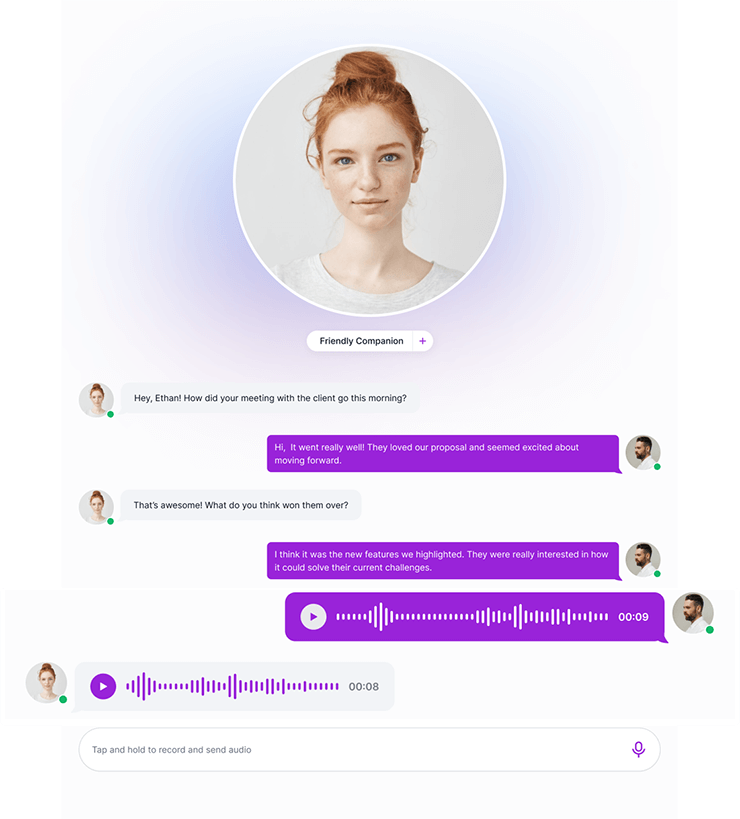
Common Gamification Pitfalls to Avoid
While gamification is powerful, poor implementation can backfire. Overemphasis on competition can alienate some employees. Complex systems without clear purpose can confuse rather than motivate. And if recognition becomes predictable or insincere, it loses impact.
To succeed, gamification must be well-designed, inclusive, and purpose-driven. It should reinforce company values, support diverse working styles, and maintain fairness across teams.
Blending Gamification with Traditional Incentives
You don’t have to choose one over the other. Many high-performing companies blend the immediacy of gamification with the gravity of traditional rewards. For example, leaderboards can culminate in a monthly bonus or team outing. Achieving gamified milestones could unlock larger rewards tied to company performance.
By implementing gamification strategies that effectively reward users, businesses can enhance their loyalty and incentive programs. Structuring incentives into engaging experiences motivates users through clear rewards, fostering a sense of achievement and encouraging repeat interactions with the brand.
Choosing the Right Model for Your Team
Not every team will respond the same way. Sales teams may thrive on competitive leaderboards, while creative teams might prefer collaborative challenges or storytelling-based gamification. Culture, roles, and company size all influence the best-fit model.
Game-based learning can be an effective model for certain teams, integrating games and game principles into the learning process to boost engagement and improve learning outcomes.
The key is to listen, iterate, and use performance data to adapt. What matters most is that your strategy aligns with what drives your people.
Designing Effective Incentive Programs
Designing effective incentive programs requires a deep understanding of the target audience, their motivations, and the desired behaviors. To create a successful incentive program, it’s crucial to tailor the rewards to the specific needs and interests of the participants. This means considering what truly motivates your sales team—whether it’s monetary rewards, public recognition, or opportunities for professional development.
A clear and transparent reward structure is essential. Participants should know exactly what they need to do to earn rewards and how their performance will be measured. Regular feedback and updates keep the program engaging and help participants stay on track. Additionally, aligning the incentive program with the overall goals and objectives of the organization ensures that the desired behaviors contribute to the company’s success.
Best Practices for Implementing Gamification and Incentives
Implementing gamification and incentives requires a strategic approach that takes into account the specific needs and goals of the organization. Here are some best practices to ensure success:
- Clearly Define the Target Audience and Desired Behaviors: Understand who your participants are and what behaviors you want to encourage. This helps in designing a program that resonates with your audience and drives the right actions.
- Design a Transparent and Easy-to-Understand Reward Structure: Make sure participants know how they can earn rewards and what those rewards are. Transparency builds trust and keeps participants engaged.
- Provide Regular Feedback and Updates: Continuous feedback helps participants understand their progress and stay motivated. Regular updates keep the program dynamic and engaging.
- Align the Program with Organizational Goals: Ensure that the incentive program supports the broader objectives of the organization. This alignment ensures that the desired behaviors contribute to overall success.
- Use a Variety of Game Mechanics and Design Elements: Incorporate different game elements to keep the program interesting. Points, badges, leaderboards, and challenges can all play a role in maintaining engagement.
- Continuously Monitor and Evaluate the Program’s Effectiveness: Regularly assess how well the program is working and make adjustments as needed. This ensures that the program remains effective and relevant.
By following these best practices, organizations can implement gamification and incentive programs that drive engagement, motivation, and performance.
Overcoming Challenges and Considerations
Implementing gamification and incentives can be challenging, and there are several considerations that must be taken into account to ensure success:
- Ensure Fairness and Transparency: Make sure the program is fair to all participants and that the rules and rewards are clearly communicated. Transparency helps build trust and prevents misunderstandings.
- Avoid Manipulative or Coercive Tactics: The program should motivate participants positively, without resorting to manipulation or coercion. This ensures that employees feel genuinely motivated rather than pressured.
- Provide Clear and Concise Explanations: Clearly explain the program’s rules, objectives, and rewards. Participants should understand how the program works and what is expected of them.
- Align with Organizational Goals: Ensure that the program supports the overall goals and objectives of the organization. This alignment ensures that the desired behaviors contribute to the company’s success.
- Continuously Monitor and Evaluate Effectiveness: Regularly assess the program’s performance and make necessary adjustments. This helps in identifying any issues early and ensures the program remains effective.
- Address Concerns and Issues Promptly: Be prepared to address any concerns or issues that arise during the program’s implementation. Prompt resolution helps maintain trust and engagement.
By considering these factors, organizations can overcome challenges and implement gamification and incentive programs that are fair, transparent, and effective.
Spinify’s Role in Effective Gamification

Spinify is purpose-built to bring gamification to life in the workplace. With easy integration into your CRM, helpdesk, or project management software, Spinify pulls in real-time performance data and turns it into live competitions, streaks, and shoutouts.
By leveraging gamification, Spinify ensures that learning outcomes are achieved by engaging learners and reinforcing knowledge application, thus meeting and retaining learning objectives over time.
Whether you’re celebrating top closers, fastest responders, or consistent collaborators, Spinify helps you recognize performance instantly, keep your team connected, and build a culture of high-energy engagement across remote and in-office teams alike.
Transform Your Team’s Journey
In conclusion, gamification and traditional incentives both boost engagement and motivation. By integrating game mechanics, organizations create engaging experiences that drive goal achievement.
Effective incentive programs align rewards with goals and provide transparency and feedback. Addressing challenges like fairness ensures trust and engagement.
While traditional incentives have value, gamification offers a modern approach that resonates with today’s workforce, motivating them to enjoy the journey.
Spinify provides innovative incentive ideas that align with your values, keeping your team motivated.
Ready to turn your team’s performance into a game they want to win?
🎯 Book a Free Demo with Spinify today and discover how gamification can drive lasting results—without the burnout.


